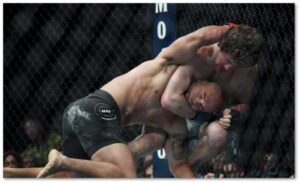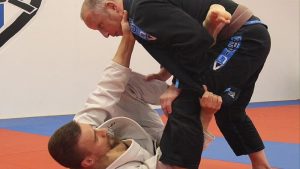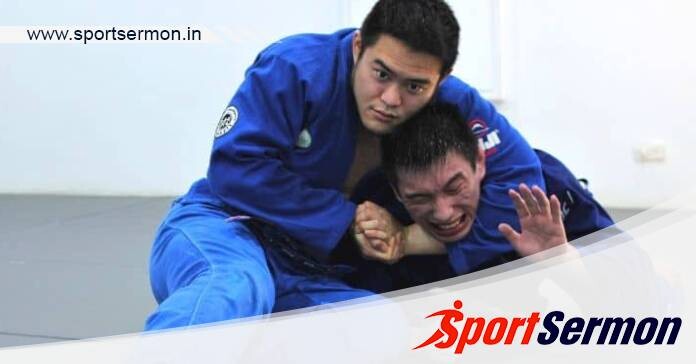BJJ Bulldog Choke: Controlling the head in Brazilian Jiu-Jitsu equates to controlling the body. The idea that the body follows the head wherever it goes is one of the fundamental concepts of BJJ. When getting beyond the guard or establishing dominance, head control is helpful, but it helps much more when using submissions. Chokes used at strange angles to the head and neck can be an efficient technique to finish off a stubborn foe. Today, we’ll discuss the bulldog choke, one of BJJ’s most lethal chokes.
The BJJ Bulldog Choke: What Is It?

The bulldog choke appears to be the choke that someone who isn’t taught is most likely to use instinctively. Someone catches them from behind with the opponent’s head low on their torso, and they are likely to hold the opponent’s head while launching a torrent of punches with their free hand or even simply giving them a powerful squeeze. This is ineffective and dangerous for a beginner since if their head control slips, the opponent can seize their back or crash them to the ground. To use this choke to eliminate your opponents safely and successfully, you must understand the correct body alignment and choking techniques.
When used properly, the bulldog choke is a powerful choke. It is a form of neck crank that resembles a rear naked choke applied in the opposite way, with your body in front of the opponent, and a guillotine applied in the same direction. It exerts pressure on the neck’s carotid arteries, just as the guillotine and rear naked choke. Depending on how the arms are held when administering the choke, the airway may be blocked, giving it the appearance of a blood choke (strangle) combined with an air choke.
This choke may seem hazardous and unusual since it is accomplished without using hooks or encircling the opponent with your legs, giving you just control over their head and neck. The choke may be used just as you are about to lose control again to catch your opponents off guard, giving it a viable choice when you find yourself in the position, even if it may not often succeed against a skilled opponent. However, keep in mind that one of the fundamental principles of BJJ is to dominate your opponents at all times while you are in a dominating position.
You might also interested in reading this: An Overview Of The BJJ Reverse X Guard
Bulldog Choke In Action
Let’s first watch the bulldog choke in action at the highest level of competition before learning how to employ it. Former Bellator and ONE Championship World Champion Ben Askren used the bulldog choke to finish MMA icon Robbie Lawler in his UFC crossover debut.
Ben is a skilled wrestler and a former member of the American Olympic Wrestling Team. He is renowned for his unbeatable wrestling abilities in the cage. Ben manages to knock Lawler out while keeping his hands and legs under control on the ground after getting him to the fence. Ben was able to keep a chest-to-back connection with a seatbelt grasp as soon as Lawler moved away and started to flee. Ben quickly switched to an S Grip and released his choking arm.
Ben was misplaced as Lawler attempted to face Ben while maintaining the chokehold. Keep in mind that Ben lacks hooks to hold the rear mount in place. Ben ultimately lands in front of Lawler, putting him in the bulldog choke position, holding Lawler’s head with the choke and a S grip. Ben, who is renowned for having a grip strong enough to use his arms to crush two watermelons, didn’t waste any time in leaning forward and tightening the choke to knock out Robbie Lawler in the opening round.
How Is The BJJ Bulldog Choke Done?

Although the bulldog choke is similar to a combination of a guillotine and rear naked choke, use caution when applying this choke with an RNC hold as you risk being turned over. The bulldog choke from the back mount is intended to be used when the opponent tries to escape to your underhand side while you have the seatbelt hold.
If you are in the back mount and your upper arm, often known as the “choking arm,” is holding your opponent’s neck in place, then you are in the choke position. Typically, the adversary would go to your underhand side and pivot their shoulder to face your body. You can maintain the position if you have the opponent’s wrist in an underhand grip. The wrist grip you use with your underhand makes it more difficult for the opponent to lower their torso and keeps their shoulder from shifting to your underhand side.
As the opponent may move away and pull their arm out, keep your body pressing into their back and keep the wrist hold. Frequently, the adversary will turn to your underhand side to start a scramble. When this occurs, spin back up and perform a bulldog choke by locking your choking hand (upper arm) with your underhand. To accomplish this, close your hands in a Gable or S grip. Once you have your opponent’s body in your clutches, apply the bulldog choke by placing your legs in front of your torso and slouching backward.
Spreading out makes it more difficult for the adversary to close the distance and assists in thwarting their effort to advance and launch a takedown attack. As you lean back against your opponent, you have more leverage and may exert more pressure, tightening the choke. Although the bulldog choke is rarely used in contests, it is unbeatable when executed correctly.
The bulldog choke only functions when the proper conditions are met. When you are in the back mount and don’t utilise hooks, the opponent is forced to face you, which you might use as bait. It would be wise to train both sides even if it is mostly used from the back mount when the opponent rotates to your inferior (underhand) side. To avoid injury, use caution when practising the choke and focus on how to perform it correctly.
This is a complete guide on BJJ Bulldog Choke. Let us know your thoughts in the comment section below.

